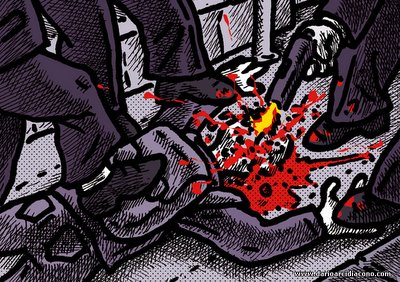Jean Charles de Menezes: shot with 'dum dum' bullets.

Just when you thought it couldn't get any worse:
The Brazilian man shot dead by police in the mistaken belief that he was a suicide bomber was killed with a type of bullet banned in warfare under international convention, The Daily Telegraph has learned.
The firing of hollow point ammunition into the head of Jean Charles de Menezes, 27, is believed to be the first use of the bullets by British police.
It will re-ignite controversy around the shooting, at Stockwell Underground station, south London, on July 22.
Modern hollow point bullets are descendants of the expanding "dum dum" ammunition created by the British in an arsenal of the same name near Calcutta, in India, at the end of the 19th century and outlawed under the Hague Declaration of 1899.
The bullets, which expand and splinter on impact, were available to officers taking part in Operation Kratos, the national police drive against suspected suicide bombers which has been described as a "shoot to kill" policy.
Their issue was sanctioned after research suggested that they were an effective close-quarters ammunition for use against someone about to trigger a suicide bomb.
It is believed the decision was influenced by the tactics used by air marshals on passenger jets - where such bullets are designed to splinter in the body and not burst the fuselage. They have been assessed as posing less risk to people around the suicide bomber than conventional bullets but the effect on victims is devastating.
Like the overall Kratos policy, the decision to make dum dum-style bullets available was taken in secret. However, it is understood that the Home Office became aware three years ago that police were considering their use.
Negotiations on possible national guidance are understood to have been inconclusive and the choice of ammunition appears to be at the discretion of police chiefs, not the Home Secretary.
There is no legal prohibition on police use of such ammunition. The Home Office confirmed last night that "chief officers may use whatever ammunition they consider appropriate to meet their operational needs".
It is understood from security sources that hollow point bullets are still available as an option to police firearms teams in Kratos-type cases.
Coming the day after Sir Ian Blair claimed that he wanted a national debate on the police and their influence and power in society in a televised lecture, this seems just slightly embarrassing. He claimed that the public should decide measures like the Kratos shoot-to-kill policy, but neglected to mention that the police had done so with little consultation with the government. It now also appears that some officers decided to use bullets which shatter within the body - meaning that if they ever actually shot a terrorist and he/she survived, let alone another innocent like Jean Charles, doctors would be unable to remove all the fragments from their body and they would likely be in pain the rest of their lives - without bothering to consult the Home Office over it, who then discovered and did nothing about it.
It then brings the question to why they felt the need to put 7 of these bullets into his head. What exactly was left of his head following the barrage? I guess the orders must be to if possible utterly destroy the brain - stopping them from activating any explosives - but Jean Charles had already been stopped and restrained. An over eager officer, a show of force on a sloppily wrongly identified man to show the police were up to the task, a tragic mistake and failure of communication or a justified reaction to a perceived threat, followed by an attempted cover-up and planting of witnesses, with the head of Met lying to a national newspaper, or a bad mistake compounded by wrong information allowed to be printed in the media? I think I know what explanation I'm more likely to believe.

